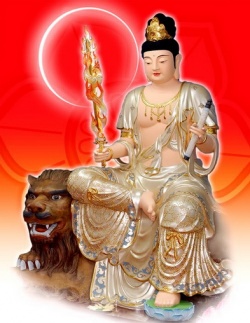Ten meanings of Dharma
Jump to navigation
Jump to search
Ten meanings of dharma (Wyl. chos kyi don bcu) — Kyabjé Dudjom Rinpoche gives ten meanings for the term dharma, quoting from Vasubandhu’s The Principles of Elucidation (Skt. Vyakhyayukti; Tib. Namshé Rigpa):
- an object of knowledge (Skt. jñeya; Wyl. shes bya),
- the path (Wyl. lam),
- nirvana (Wyl. mya ngan las 'das pa),
- a mental object (Skt. manoviṣaya; Wyl. yid kyi yul),
- merit (Wyl. bsod nams),
- life (Skt. āyu; Wyl. tshe),
- teachings of the Buddha, or its scriptures (Skt. dharmapravacana; Wyl. gsung rab),
- what is subject to age or change, i.e. material objects (Wyl. 'byung 'gyur),
- rules (Wyl. nges pa) or religious vows, and
- spiritual traditions (Skt. dharmanīti; Wyl. chos lugs).
They all relate to the sense of ‘holding’, which is the meaning of dhṛ, the root of the word dharma.
The general usage in English for the typography of the term 'dharma' is to use an upper case when referring to Buddha's teachings, the path or the truth of cessation (cases 2, 3 & 7).
